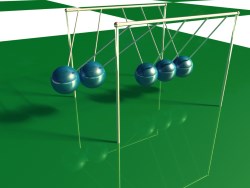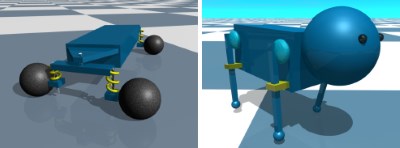Publications
Constraint-based collision and contact handling using impulses

In this paper a new method for handling collisions and permanent contacts between rigid bodies is presented. Constraint-based methods for computing contact forces with friction provide a high degree of accuracy. The computation is often transformed into an optimization problem and solved with techniques like linear or quadratic programming. Impulse-based methods compute impulses to prevent colliding bodies from interpenetrating. The determination of these impulses is simple and fast. The impulse-based methods are very efficient but they are less accurate than the constraint-based methods because they resolve only one contact between two colliding bodies at the same time. The presented method uses a constraint-based approach. It can handle multiple contacts between two colliding bodies at the same time. For every collision and contact a non-penetration constraint is defined. These constraints are satisfied by iteratively computing impulses. In the same iteration loop impulses for dynamic and static friction are determined. The new method provides the accuracy of a constraint-based method and is efficient and easy to implement like an impulse-based one.
@inproceedings{Bender06,
author = {Jan Bender and Alfred Schmitt},
title = {Constraint-based collision and contact handling using impulses},
booktitle = {Proceedings of the 19th international conference on computer animation and social agents},
year = {2006},
month = jul,
address = {Geneva (Switzerland)},
pages = {3-11}
}
Fast Dynamic Simulation of Multi-Body Systems Using Impulses

A dynamic simulation method for multi-body systems is presented in this paper. The special feature of this method is that it satisfies all given constraints by computing impulses. In each simulation step the joint states after the step are predicted. In order to obtain valid states after the simulation step, impulses are computed and applied to the connected bodies. Since a valid joint state is targeted exactly, there is no drift as the simulation proceeds in time and so no additional stabilisation is required. In previous approaches the impulses for a multi-body system were computed iteratively. Since dependencies between joints were not taken into account, the simulation of complex models was slow. A novel method is presented that uses a system of linear equations to describe these dependencies. By solving this typically sparse system the required impulses are determined. This method allows a very fast simulation of complex multi-body systems.
@inproceedings{Bender06,
author = {Jan Bender and Alfred Schmitt},
title = {Fast Dynamic Simulation of Multi-Body Systems Using Impulses},
booktitle = {Virtual Reality Interactions and Physical Simulations (VRIPhys)},
year = {2006},
month = nov,
address = {Madrid (Spain)},
pages = {81-90}
}
Previous Year (2005)

